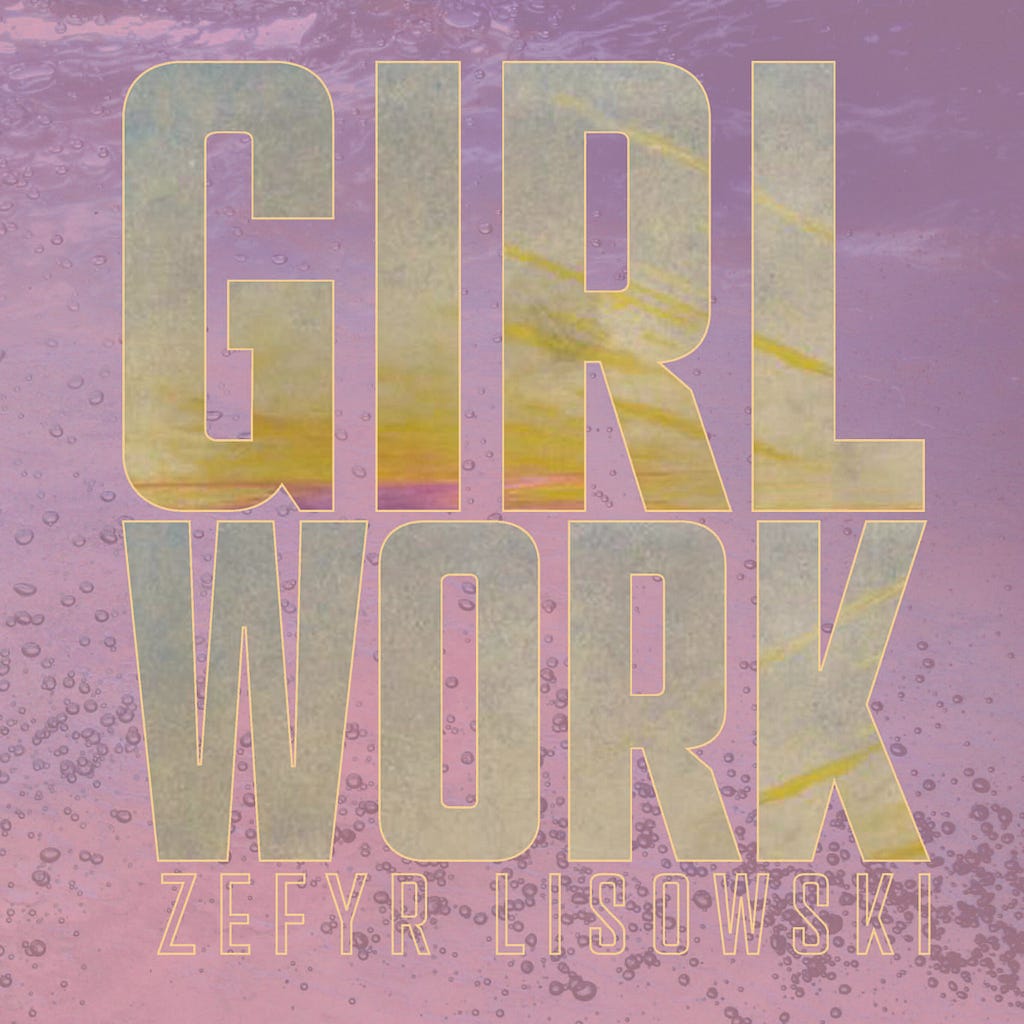
Consider gender in the interrogative. In Girl Work, Zefyr Lisowski opens her self(/)text with a query: “Are you listening?” And it is indeed this demand for attention, or, perhaps, this longing for an interlocutor, that underlies Lisowski’s creative project.
Girl Work is a poetic chameleon of a book, featuring a selection of formally-familiar poems interspersed with profound disruptions: texts periodically take the shapes of: girl, spiral (which is also girl), impenetrable collage or (perhaps) fallen scrapbook, scrap pile or (perhaps) boneyard. Lisowski is a writer of beauty, acutely aware that one cannot write the weapon of beauty under cisheteropatriarchy without the violences that accompany it.
Lisowski is oriented toward, yet not bound to, a poetry of shape: in “Poem With Dead Girl In It” (16) she thrusts readers back to a childhood sense of frightening ambiguity. The poem’s architecture invites us to squint as recognition — as faggot, as girl, as something beyond the strictures of boyhood — takes the shape of violent desire. Ensconced by an autobiographical frame, “I loved being in middle school because my hesitation transformed into something more elusive” come the broken-up, italicized lines of a young boy discovering the tenuous path between attraction and disdain: the line, “I will tell you little fag,” drills a hole in the center of the poem-object, perhaps hollowing a space for the titular dead girl’s body to rest.
Holes, caves, carve-outs, hollow-ins: these emerge again and again as concomitant labors to that of girlhood itself. Indeed, the work of being a girl, in this text, is very much the work of compensation, for explicit, unchosen hollownesses and chosen opacities alike. In the latter case, Lisowski flexes kinship with more-than-human people, envisioning a girlhood — and, particularly, a trans girlhood — which frustrate interlocutors’ attempts at definition. The girlbody is “a seaside,” punnily confounding the “news anchor”’s attempts to weigh it down with meaning (19). Elsewhere, the speaker of these poems is gilled, a blood-strewn shark who declares, “I have nothing to tell you about the longings netted over me” (72). This move, reminiscent of poetic interventions in McKenzie Wark’s Reverse Cowgirl and jos charles’s feeld, move the locus of trans poetics from attention to trans identity to one of trans imbrication in that which is difficult to see and harder to know. She writes, instead, from the opaque corners of trans subjectivity: “This is not an invitation” (24).
At other points, Girl Work comes into view with startling clarity. In the titular long prose-poem that may be more aptly called an essay-in-verse, Lisowski’s thesis statement emerges:
And this is what I say to you. A girl is a kind of work. A body a
kind of bird. A cage a kind of artwork. (66)
In the subsequent pages, Lisowski genealogizes intimate partner abuse, citing it not only as a traumatic life event but also an ontological disruption: the beauty that once structured one’s life had been stripped, even clipped:
When I clipped the wings of my beauty, I put them in a lockbox
and did not let them out until they were good and dead.
When they were good and dead the man’s beauty became
overwhelming to me. (66)
Here, an abuser is not only the perpetrator of material harm, but also attempts to usurp authorial control of the speaker’s life: “the violations began to emerge,” writes Lisowski, confined to the passive voice. She writes, (un)thinks, and sometimes attacks from a rattling cage, whose echoes spill beyond the lines of the poem “Girl Work” itself. In “Poem Only About Beauty,” (70) which follows, gentle ekphrasis gives way to a deluge of intrusive desire. The bottom of the page features overlapping lines such as: “A fuckibility. A Fuckibility. A Fuckibility,” “flesh, soft and warm. Well water. A horror film,” “Here’s a beautiful thing. Here’s another. Here’s another,” “Where are you going, bitch?” and perhaps most saliently, “This too is a kind of beauty” [bold in original].
An opaque poetics of trans girlhood holds space for beauty as well as grief at its consequences; Girl Work moves toward its conclusion with a refusal of conclusiveness — to transition, to trauma, to the poems archiving both. But what is to be done with a life once organized around beauty, when beauty as purity, goodness, and even salvation has been dethroned? Lisowski identifies beauty as a thing to be given, to be audiences and consumed, offering a fantasy to men behind computers while starving, “drink[ing] [her]self thin” (28). Even while it remains the case that to be a woman who does not long to be beautiful is to be an anomaly, if not a pariah, Lisowski warns against the very hollowness the sole pursuit of beauty can wreak. Indeed, throughout Girl Work, an embrace of ugliness — mess on the page, truths hard to swallow — afford her authorial autonomy over this very collection.
From the opening of Girl Work, girlhood manifests simultaneously as a violation, as a dream, as a necessity, as a doom; its labors overshadowing life even when she “wasn’t even a girl yet” (3). And yet, girlhood and its realization are a necessity to her survival: this dazzling contradiction not only fills the core of Girl Work but lingers in its wake, creating, perhaps, new conditions of possibility in which other girlhoods may grow and thrive. Girl Work is a collection both clear-eyed to the traumas of life under cisheteropatriarchy, and yet keenly insightful as to the “great, fucked, flawed beauty” (82) to be found in the margins.
Zefyr Lisowski. Girl Work. Noemi Press, March 2024. ISBN: 978–1–955992–04–6. 88pp.
Poetic Conversations: After Beauty: A Review of Girl Work by Zefyr Lisowski was originally published in ANMLY on Medium, where people are continuing the conversation by highlighting and responding to this story.
